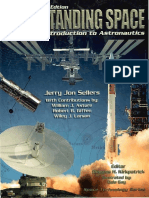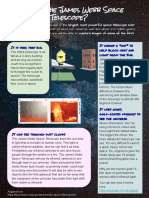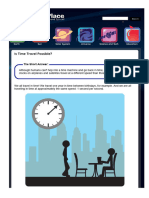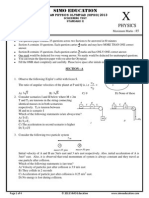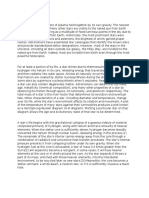0 ratings0% found this document useful (0 votes)
Topic A Little Explanition About It, and An Activity: The Solar System
Topic A Little Explanition About It, and An Activity: The Solar System
Uploaded by
nemfogomThe document proposes several activities for teaching kids about space science concepts:
1) Creating a miniature solar system on a soccer field using objects to represent planets scaled to their distances from the sun.
2) Having kids dress as astronauts and take photos in front of a poster depicting the moon landing.
3) Making small planet models out of materials like styrofoam to represent the different types of planets.
4) Explaining navigation tools like compasses and using them in an activity to teach how sailors navigated.
Copyright:
© All Rights Reserved
Available Formats
Download as XLSX, PDF, TXT or read online from Scribd
Download as xlsx, pdf, or txt
Topic A Little Explanition About It, and An Activity: The Solar System
Topic A Little Explanition About It, and An Activity: The Solar System
Uploaded by
nemfogom0 ratings0% found this document useful (0 votes)
The document proposes several activities for teaching kids about space science concepts:
1) Creating a miniature solar system on a soccer field using objects to represent planets scaled to their distances from the sun.
2) Having kids dress as astronauts and take photos in front of a poster depicting the moon landing.
3) Making small planet models out of materials like styrofoam to represent the different types of planets.
4) Explaining navigation tools like compasses and using them in an activity to teach how sailors navigated.
Original Title
Astronomy_Activities_2019_NJY_Camps_Gaál_Balázs
Copyright
© © All Rights Reserved
Available Formats
XLSX, PDF, TXT or read online from Scribd
Share this document
Did you find this document useful?
Is this content inappropriate?
The document proposes several activities for teaching kids about space science concepts:
1) Creating a miniature solar system on a soccer field using objects to represent planets scaled to their distances from the sun.
2) Having kids dress as astronauts and take photos in front of a poster depicting the moon landing.
3) Making small planet models out of materials like styrofoam to represent the different types of planets.
4) Explaining navigation tools like compasses and using them in an activity to teach how sailors navigated.
Copyright:
© All Rights Reserved
Available Formats
Download as XLSX, PDF, TXT or read online from Scribd
Download as xlsx, pdf, or txt
0 ratings0% found this document useful (0 votes)
Topic A Little Explanition About It, and An Activity: The Solar System
Topic A Little Explanition About It, and An Activity: The Solar System
Uploaded by
nemfogomThe document proposes several activities for teaching kids about space science concepts:
1) Creating a miniature solar system on a soccer field using objects to represent planets scaled to their distances from the sun.
2) Having kids dress as astronauts and take photos in front of a poster depicting the moon landing.
3) Making small planet models out of materials like styrofoam to represent the different types of planets.
4) Explaining navigation tools like compasses and using them in an activity to teach how sailors navigated.
Copyright:
© All Rights Reserved
Available Formats
Download as XLSX, PDF, TXT or read online from Scribd
Download as xlsx, pdf, or txt
You are on page 1/ 4
Topic A little explanition about it, and an activity
What do you think if kids could do a mini solar
system at a playing-field? For example at a soccer
field. The Sun would be a beach ball and opposit
The Solar System to it, but at the other end of the field would be
Neptun. Between theese two, kids could figure
out where do each planet goes. Kuiper belt would
be made from sand. If anything goes to scale
according to Sun, the size comparison will be
stunning! Furthermore, every kid could make
their own miniature Solar System, so they will
have some memories from the camp! *This topic
is strongly connects to the two types of planets.
Moonlanding: Everything explained with fun! Kids
The Moon
could have a clothing just like Neil Armstrong
had, and we could do some land to look like the
Moon and at the background there would be a
poster about Space and Earth, so they can be
photographed on it and they parents would be
proud for their little astronaut :)
Kids could make little planets from styrofoam and
paper then paint it to look like a miniature
The two types of planets (Rocky, replica, just like the one I showed you in the
and Gas) video chat. *This topic strongly connects to the
Solar System's.
How did sailors used it for navigation. They could
The Pole Star learn about the GPS and the compass too while
they use them. It's gonna be a lifetime lesson for
them, cause nowadays it is required so they
won't get lost :)
Since we have a great technology, we know in
real time without many boring searching where
Observation are the Celestial Objects, so I can set up the
telescopes and spot them quickly, than kids can
see them. If we are lucky enough, we will spot
the ISS or some space debris. It would be fun to
do it with a laser at night.
Once, my physics teacher made a rocket from a
PET bottle. It is hard to discuss how does it work,
but I enclosed a picture and a video. Kids would
Spaceship love it! It can fly up to 10-15 meters.
A rubber sheet is fixed to a circular stand. At the
center, there is a heavy steel orb. It will press
Gravitation down the rubber. It is our Sun. If you drop any
other, but lighter steel orbs they will start an
ellipse orbit around the "Sun". It represents in
minutes how does the Sun attract planets. It is
very spectecular! Not just kids, but adults would
enjoy it.
Materials needed Time needed
Beach balls from small to Maybe half an hour?
huge for the planets; Sand;
Styrofoam; Paper; Paint;
Glue; Wood (To fix their
planets)
Astronaut costume; Poster;
Camera
Styrofoam; Paper; Paint; Depends on kid's speed and
Glue; Wood (To fix their agility.
planets)
GPS; Compass 10 mins of explanition and
another 10 minutes so they
can try them
All of the telescopes you sent
me could be used. A laser
should be bought. Every kid could watch them
for like half an hour. If you
think it's a great idea, I'd be
willing to do observation with
bigger groups at night.
Maybe every second or third
night 2-3 hours?
PET bottle; plug; sewage pipe The spaceship should be
(50cm); pump; water; made before camp starts. It
could be sent to the sky with
every group. It takes only
some minutes. Kids in my
school played hours with it!
Rubber sheet; A circular The attraction is only ~5
stand; some orbs (Each of minutes. And another 5
them is different sized due to minutes explanation.
planet's different mass);
You might also like
- UnderstandingSpace-An Introduction To Astronautics100% (21)UnderstandingSpace-An Introduction To Astronautics790 pages
- Savage Worlds - Seven Worlds - Campaign Book (Updated) PDF75% (4)Savage Worlds - Seven Worlds - Campaign Book (Updated) PDF258 pages
- Speaker Template 5x7 - 6x8 To Ø165mm - 6.5' - Mazda 3No ratings yetSpeaker Template 5x7 - 6x8 To Ø165mm - 6.5' - Mazda 31 page
- Braun Espresso Master Professional E400 3060 SMNo ratings yetBraun Espresso Master Professional E400 3060 SM11 pages
- Astroquizzical: A Curious Journey Through Our Cosmic Family TreeFrom EverandAstroquizzical: A Curious Journey Through Our Cosmic Family TreeNo ratings yet
- (Ebook) LEGO Space: Building the Future by Reid, Peter, Goddard, Tim ISBN 9781593275211, 1593275218 All Chapters Instant Download100% (1)(Ebook) LEGO Space: Building the Future by Reid, Peter, Goddard, Tim ISBN 9781593275211, 1593275218 All Chapters Instant Download67 pages
- Intro To Astronomy: The Wonderful Universe ofNo ratings yetIntro To Astronomy: The Wonderful Universe of48 pages
- Human Contact - Dreamation 2010 PreviewNo ratings yetHuman Contact - Dreamation 2010 Preview20 pages
- Lift Off To The International Space Station With NogginNo ratings yetLift Off To The International Space Station With Noggin7 pages
- How Do You Make A Weather Satellite? How Do You Make A Weather Satellite?No ratings yetHow Do You Make A Weather Satellite? How Do You Make A Weather Satellite?12 pages
- Incredibly True... : A Word From THE TeamNo ratings yetIncredibly True... : A Word From THE Team1 page
- Colonizing Venus With Floating Cities - Universe TodayNo ratings yetColonizing Venus With Floating Cities - Universe Today20 pages
- Sistemas solares: Planetas, estrellas y órbitas: Solar Systems: Planets, Stars, and OrbitsFrom EverandSistemas solares: Planetas, estrellas y órbitas: Solar Systems: Planets, Stars, and OrbitsNo ratings yet
- We Are All Astronauts: Discover what it takes to be a space explorer!From EverandWe Are All Astronauts: Discover what it takes to be a space explorer!No ratings yet
- ASTRONOMY HANDBOOK For Instructors CornerNo ratings yetASTRONOMY HANDBOOK For Instructors Corner229 pages
- A Trip To The International Space StationNo ratings yetA Trip To The International Space Station12 pages
- The Universe in a Box: Simulations and the Quest to Code the CosmosFrom EverandThe Universe in a Box: Simulations and the Quest to Code the CosmosNo ratings yet
- The Sun: SMA Solar Technology AG Solar Is Future For KidsNo ratings yetThe Sun: SMA Solar Technology AG Solar Is Future For Kids12 pages
- A Celestial Dance: A. Manzanares, Grade 1: Additional Unit LessonNo ratings yetA Celestial Dance: A. Manzanares, Grade 1: Additional Unit Lesson8 pages
- Summer Holiday Homework Science - Class 6 2023No ratings yetSummer Holiday Homework Science - Class 6 20235 pages
- Translocation in The Phloem: Phloem and Xylem Are Structures For Long-Distance TransportNo ratings yetTranslocation in The Phloem: Phloem and Xylem Are Structures For Long-Distance Transport25 pages
- Hop Timing Average Alpha Acid Region Used ForNo ratings yetHop Timing Average Alpha Acid Region Used For42 pages
- Brewery Equipment For Sale Item Producer Pcs Prod - YearNo ratings yetBrewery Equipment For Sale Item Producer Pcs Prod - Year2 pages
- Galileo's Telescope: History, Scientific Analysis, and Replicated ObservationsNo ratings yetGalileo's Telescope: History, Scientific Analysis, and Replicated Observations15 pages
- Collimating Orion Starmax and Apex Maksutov-Cassegrain TelescopesNo ratings yetCollimating Orion Starmax and Apex Maksutov-Cassegrain Telescopes3 pages
- Technical Specifications: and Mechanical CapacityNo ratings yetTechnical Specifications: and Mechanical Capacity1 page
- Architect of Worlds - Special Cases in Worldbuilding (0.1)No ratings yetArchitect of Worlds - Special Cases in Worldbuilding (0.1)21 pages
- Satellogic - Asset Monitoring Data Sheet April 2023No ratings yetSatellogic - Asset Monitoring Data Sheet April 20232 pages
- Handicapped Children Daycare Educational Center by SlidesgoNo ratings yetHandicapped Children Daycare Educational Center by Slidesgo39 pages
- 6 Space Physics Revision 6.2 Stars and the Universe IGCSE Physics Chris Gozzard PhysicsNo ratings yet6 Space Physics Revision 6.2 Stars and the Universe IGCSE Physics Chris Gozzard Physics2 pages
- Aptis Practice Test 4 Full Aptis Sin RespuestsNo ratings yetAptis Practice Test 4 Full Aptis Sin Respuests12 pages
- The Night Sky Is Turning Into The Light SkyNo ratings yetThe Night Sky Is Turning Into The Light Sky4 pages
- Physical Science q4 WK 1 Korekted FinalNo ratings yetPhysical Science q4 WK 1 Korekted Final13 pages
- L3 Our Solar System and Our Place in Our Universe - StudentNo ratings yetL3 Our Solar System and Our Place in Our Universe - Student5 pages
- 8 Judging The Revolution Figure (Solar Return Chart) : 102 Annual Predictive Techniques100% (2)8 Judging The Revolution Figure (Solar Return Chart) : 102 Annual Predictive Techniques9 pages
- UnderstandingSpace-An Introduction To AstronauticsUnderstandingSpace-An Introduction To Astronautics
- Savage Worlds - Seven Worlds - Campaign Book (Updated) PDFSavage Worlds - Seven Worlds - Campaign Book (Updated) PDF
- Speaker Template 5x7 - 6x8 To Ø165mm - 6.5' - Mazda 3Speaker Template 5x7 - 6x8 To Ø165mm - 6.5' - Mazda 3
- Astroquizzical: A Curious Journey Through Our Cosmic Family TreeFrom EverandAstroquizzical: A Curious Journey Through Our Cosmic Family Tree
- (Ebook) LEGO Space: Building the Future by Reid, Peter, Goddard, Tim ISBN 9781593275211, 1593275218 All Chapters Instant Download(Ebook) LEGO Space: Building the Future by Reid, Peter, Goddard, Tim ISBN 9781593275211, 1593275218 All Chapters Instant Download
- Lift Off To The International Space Station With NogginLift Off To The International Space Station With Noggin
- How Do You Make A Weather Satellite? How Do You Make A Weather Satellite?How Do You Make A Weather Satellite? How Do You Make A Weather Satellite?
- Colonizing Venus With Floating Cities - Universe TodayColonizing Venus With Floating Cities - Universe Today
- Sistemas solares: Planetas, estrellas y órbitas: Solar Systems: Planets, Stars, and OrbitsFrom EverandSistemas solares: Planetas, estrellas y órbitas: Solar Systems: Planets, Stars, and Orbits
- Infinite Wonder: An Astronaut's Photographs from a Year in SpaceFrom EverandInfinite Wonder: An Astronaut's Photographs from a Year in Space
- We Are All Astronauts: Discover what it takes to be a space explorer!From EverandWe Are All Astronauts: Discover what it takes to be a space explorer!
- The Universe in a Box: Simulations and the Quest to Code the CosmosFrom EverandThe Universe in a Box: Simulations and the Quest to Code the Cosmos
- The Sun: SMA Solar Technology AG Solar Is Future For KidsThe Sun: SMA Solar Technology AG Solar Is Future For Kids
- A Celestial Dance: A. Manzanares, Grade 1: Additional Unit LessonA Celestial Dance: A. Manzanares, Grade 1: Additional Unit Lesson
- Post Earth: Searching the Stars for New LifeFrom EverandPost Earth: Searching the Stars for New Life
- Translocation in The Phloem: Phloem and Xylem Are Structures For Long-Distance TransportTranslocation in The Phloem: Phloem and Xylem Are Structures For Long-Distance Transport
- Brewery Equipment For Sale Item Producer Pcs Prod - YearBrewery Equipment For Sale Item Producer Pcs Prod - Year
- Galileo's Telescope: History, Scientific Analysis, and Replicated ObservationsGalileo's Telescope: History, Scientific Analysis, and Replicated Observations
- Collimating Orion Starmax and Apex Maksutov-Cassegrain TelescopesCollimating Orion Starmax and Apex Maksutov-Cassegrain Telescopes
- Architect of Worlds - Special Cases in Worldbuilding (0.1)Architect of Worlds - Special Cases in Worldbuilding (0.1)
- Satellogic - Asset Monitoring Data Sheet April 2023Satellogic - Asset Monitoring Data Sheet April 2023
- Handicapped Children Daycare Educational Center by SlidesgoHandicapped Children Daycare Educational Center by Slidesgo
- 6 Space Physics Revision 6.2 Stars and the Universe IGCSE Physics Chris Gozzard Physics6 Space Physics Revision 6.2 Stars and the Universe IGCSE Physics Chris Gozzard Physics
- L3 Our Solar System and Our Place in Our Universe - StudentL3 Our Solar System and Our Place in Our Universe - Student
- 8 Judging The Revolution Figure (Solar Return Chart) : 102 Annual Predictive Techniques8 Judging The Revolution Figure (Solar Return Chart) : 102 Annual Predictive Techniques
